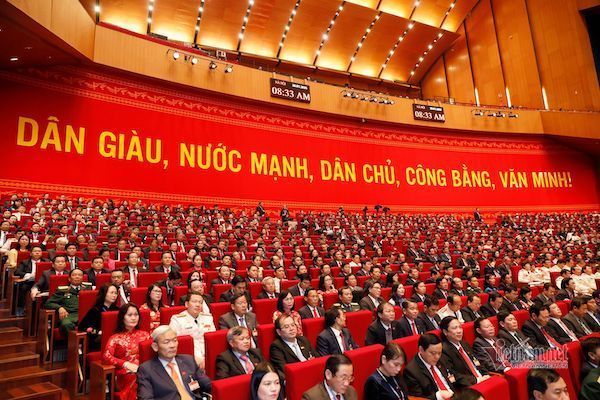 |
|
Delegates attend the 13th National Party Congress. Photo: Pham Hai
|
At the opening ceremony of the 13th Party Congress yesterday, Party General Secretary and President Nguyen Phu Trong presented the Party Central Committee’s report on documents submitted to the Congress, which emphasized the objective: improving leadership, ruling capacity and fighting power of the Party; building a clean, strong, comprehensive Party and political system; strengthening people's trust in the Party, State, and socialist regime; arousing aspirations for developing a prosperous and happy country, promoting the will and strength of great national solidarity combined with the power of the times; comprehensively and synchronously promoting renovation, industrialization and modernization; building and firmly defending the Fatherland, maintaining a peaceful and stable environment; and striving for the goal of turning Vietnam into a socialist-oriented developed country by mid-21st century.
The specific objectives in the coming decades are: By 2025, Vietnam will be a developing country with modern industry, surpassing the low middle income status. By 2030, Vietnam will be a developing country with modern industry and high average income. By 2045, it will become a developed country with high income.
VietNamNet would like to introduce articles on this topic with the desire to contribute a voice for Vietnam to achieve these goals.
Vietnam has been evaluated positively in many aspects, especially its anti-epidemic and economic prospects, by many international organizations.
Turning point for recovery
International organizations have evaluated Vietnam's outlook as positive, with a growth rate of about 6.8% in 2021 by the World Bank (WB), 6.1% by the Asian Development Bank (ADB), and up to 7.6% by HSBC.
World Bank Country Director for Vietnam Carolyn Turk said: "Vietnam is facing a turning point after recovering from Covid-19."
This outlook is based on the fact that Vietnam has effectively controlled the Covid-19 epidemic and grew by nearly 3% in 2020, according to the World Bank.
Thus, the growth rate forecasted by international organizations as well as the growth target set by the Vietnamese Government are optimistic compared to the growth rate of 2.91% in 2020.
Recently, the International Monetary Fund (IMF) said that Vietnam's GDP reached more than $340.6 billion in 2020, surpassing Singapore, to become the fourth largest economy in Southeast Asia.
Prime Minister Nguyen Xuan Phuc affirmed that in 2020, in spite of many difficulties, Vietnam successfully implemented the "dual goal" of preventing the epidemic and maintaining economic growth of 2.91%, and was listed in the group of countries with the highest growth rates in the region and the world.
"Vietnam is one of the few economies with positive growth in the world and the region, while still maintaining macroeconomic stability, controlling inflation, and ensuring major economic balances," he said.
According to the World Bank, with economic growth of 6.8% per year during the 2016-2019 period, Vietnam is among the 10 countries with the highest economic growth rate. The Economist in August 2020 ranked Vietnam in the top 16 most successful emerging economies in the world.
Over the past four years, the economy has created more than 8 million new jobs for people of working age and for those who had lost their jobs. At the same time, per capita income has increased by nearly 145%, and per capita income when adjusted by purchasing power parity (PPP) is equivalent to nearly $9,000.
Meanwhile, HSBC commented, the Covid-19 crisis highlighted Vietnam's strength as a flexible economy and production base, while continuing to allow Vietnam to maintain its position as a bright star in the region.
"For 2021, we believe that Vietnam will benefit from a technology-led recovery, persistent FDI inflows and many signed trade agreements," it commented.
The measure of the economy
Macroeconomic stability and a positive economic outlook have caused the stock market to explode steadily after falling quite deeply, as foreign investors withdrew capital at the time of the pandemic outbreak in early 2020.
By the end of the year, the VN-Index reached the growth rate of 14.9% compared to the beginning of the year and increased 67% compared to the lowest period.
According to Finance Minister Dinh Tien Dung, liquidity in the stock market has increased dramatically, reaching an average of nearly VND7.400 trillion per session. Market capitalization of the stock market reached more than 84% of GDP in 2020.
Up to 84% of large-scale public companies in the stock market are profitable, a very high rate during the year of Covid-19 in comparison with other areas of the economy.
"Vietnam's stock market has been recognized as one of the most resilient and best recovering markets in the world," said Dung.
Despite the Covid-19 pandemic, the total FDI into Vietnam in 2020 was estimated at $28.5 billion.
Vietnamese goods exported worldwide
According to the World Bank, Vietnam's export of goods reached the largest trade surplus ever and foreign exchange reserves increased. The inflows of foreign investment, combined with the surge in exports of goods, made up for the loss of foreign currency earnings due to the decline in tourism and the narrowing of remittances.
By the end of 2020, Vietnam exported at a value of $281.5 billion, up 6.5% compared to 2019, and was one of the economies with the highest export rate in the world in the context of the pandemic. The trade surplus was at a record level of $19.1 billion. Total import-export turnover reached over $500 billion for the second consecutive year.
According to reports, in 2020 the United States was the largest export market of Vietnam with turnover of $76.4 billion, an increase of 24.5% over the previous year and Vietnam had a trade surplus of nearly $62.7 billion. This achievement became one of the reasons for the US to accuse Vietnam of being a "currency manipulator".
Vietnam tried to explain to the United States that Vietnam was very aggressive in taking concrete actions to reduce the trade deficit, fight origin fraud and illegal transmission. In addition, Vietnam is determined to work with the United States to implement a joint action plan towards a harmonious and sustainable balance of trade. Furthermore, the monetary policy of Vietnam is aimed at achieving the goal of controlling inflation and stabilizing the macro-economy, and not to create a competitive position in trade.
Bottlenecks that need to be removed
However, according to Dr. Nguyen Dinh Cung, former Director of the Central Institute for Economic Management, the internal weaknesses of the economy have not been thoroughly dealt with, even before the Covid-19 pandemic.
This includes the low efficiency of resource use, especially public investment and state-owned enterprises. The driving force for growth is still mainly based on increased investment capital, the use of low-cost labor and the export of processed products. The scientific and technological capacity and level are low, resulting in low labor productivity. And the private sector is weak in finance, governance and technological capacity, and not yet connected or still at a low level on the global value chain.
Mr. Cung commented that these internal weaknesses have been more and more revealed, and even more after the Covid-19 epidemic. Bad debts left over from the previous financial crisis have not been fully resolved. The openness of the economy is increasing, but the economy is more dependent on foreign investment and some markets, affecting the economy's resilience to external fluctuations.
The willingness to adopt 4.0 technology, digital transformation and new business models is low, leading to the inability to exploit and promote the effective application of these technologies.
Identifying internal weaknesses in the economy helps to identify solutions to overcome those weaknesses, thereby improving prospects of economic recovery and a breakthrough, as assessed by the World Bank.
Tu Giang

13th National Party Congress: Hanoi, HCM City aim for digital government
Hanoi and Ho Chi Minh City both plan to develop synchronous, inter-connected digital, IT, and data infrastructure, creating a foundation for digital economic and social development.

Vietnam shows its 'firm stuff' after five years of difficulties
The US-China trade war, Brexit, the US withdrawal from TPP, Covid-19 and internal difficulties all have affected Vietnam’s economy in the last five years.